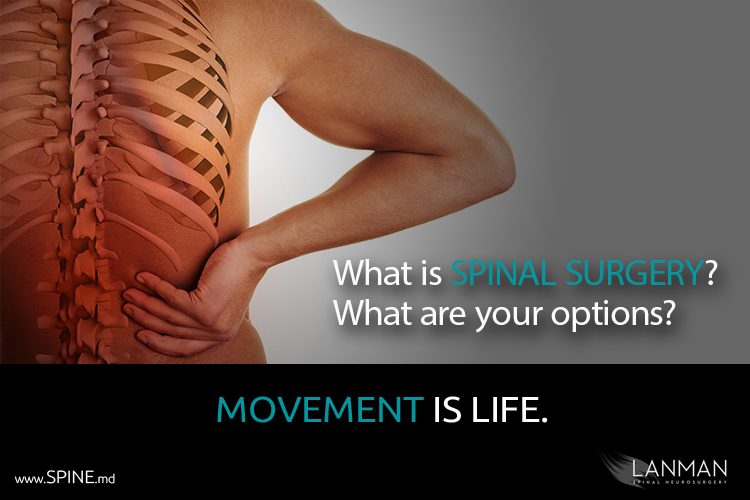A general guide for online researchers.
These descriptions are based on frequently asked questions from my patients. I give these summaries to help patients understand the procedures I am prescribing. Use these descriptions as a guide for your own path back to wellness. Remember that the term “cervical” refers to the neck area, “thoracic” refers to the center core of the body, and “lumbar” refers to the lower back.
Spinal Fusion Surgery
Spinal fusion surgery is brute force against back or neck pain. The surgery is designed to stop motion of the vertebral level or segment that is generating pain. The goal is to decrease pain caused by a herniated disc, a facet joint, compressed nerve, or all three. Although this is one surgical procedure, there are many approaches to spinal fusion surgery. The most common method involves a bone graft or synthetic graft added to the disc space to the level where the work is needed. Sometimes, other graft enhancing bone material is added to increase the growth of bone through that area. The graft grows between two vertebral segments to create one vertebral segment. The resulting bony fusion replaces a mobile level with one that is immobile, thus stopping motion and preventing pain generation. Fusion surgery is recommended where there is abnormal movement or other instability at a vertebral level that results in severe pain. Accompanying the pain is the inability to function normally without long-term pain management (e.g., OTC or prescription drugs). Among the diagnoses that may apply: severe degenerative disc disease, spondylolisthesis (due to a small fracture, severe degeneration, post-laminectomy destabilization which has created further instability), weak or unstable spine due to infection or tumor, fractures, severe scoliosis, or kyphotic deformity.
Artificial Disc Replacement Surgery
Artificial disc replacement (ADR) surgery was first approved in 2007 for the cervical region of the spine (2005 for lumbar applications). Unlike fusion, disc replacement is intended to help the patient preserve as much natural movement as possible while eliminating the typical pain generators mentioned earlier. Artificial discs are designed to mimic the form and function of original discs. Most of them consist of metal (e.g., titanium, chrome) or a combination of metal and a semi-flexible synthetic biopolymer (plastic). In very simple terms, a damaged disc is removed (discectomy) and replaced by an artificial one. The U.S. Food & Drug Administration (FDA) has approved several different models for use in lumbar and cervical applications. For lumbar applications, ProDisc-L, Activ-L, and Charite. In cervical applications, Prestige ST and LP artificial discs, Mobi-C, ProDisc-C, Bryan Disc, Secure-C, and PCM. There are no artificial disc replacement options for thoracic spine applications at this time. Although the procedure is comparatively new (spinal fusion has been used for more than 70 years), artificial disc replacement surgery is gaining full acceptance by physicians and insurers alike because the results are clearly superior to that of fusion particularly in the cervical spine. Ideal candidates for the procedure include patients who have varying degrees of disc degeneration or disc herniation and are experiencing chronic and persistent back or neck pain and associated leg or arm pain.
Microdiscectomy
Microdiscectomy may also be called microdecompression, where a small portion of bone (a few millimeters) is removed to relieve neural ‘impingement’ (pinching). By giving the nerve root more room, the procedure should provide relief of associated pain related to the pinching of the nerve and allows for the nerve to heal. Typically, a microdiscectomy is performed for a herniated lumbar disc. The reason is that this procedure is very useful for easing leg pain, but not as effective in treating patients with central low back pain. There are two standard options in outpatient lumbar discectomies: (1) microdiscectomy and (2) endoscopic or percutaneous discectomy. Microdiscectomy is usually an outpatient procedure performed through a small incision approximately 1 inch in length in the midline of the low back. The method targets neural decompression as a cure for patients with ‘pinched nerves’ as a result of disc degeneration or the growth of bone spurs or narrowing of the foraminal hole where the nerve exits the spinal cord. The surgeon removes the herniated portion of the lumbar disc and any other fragments within the disc space that may interfere with the nerve. The goal is to free up the nerve (decompression). Microdiscectomy may be prescribed to provide relief for radiculopathy (numbness or tingling) or sciatica (pain) in the buttocks, leg, and posterior thigh area.
###







